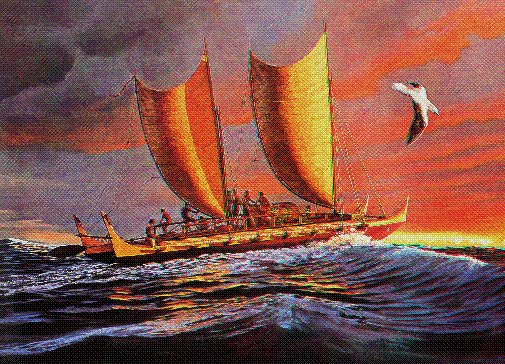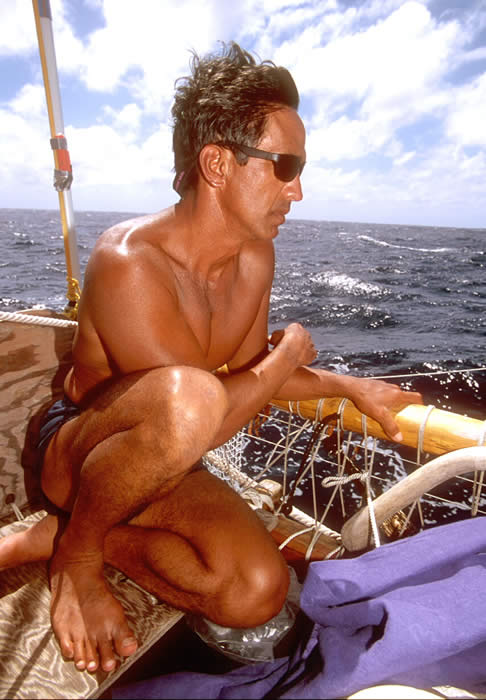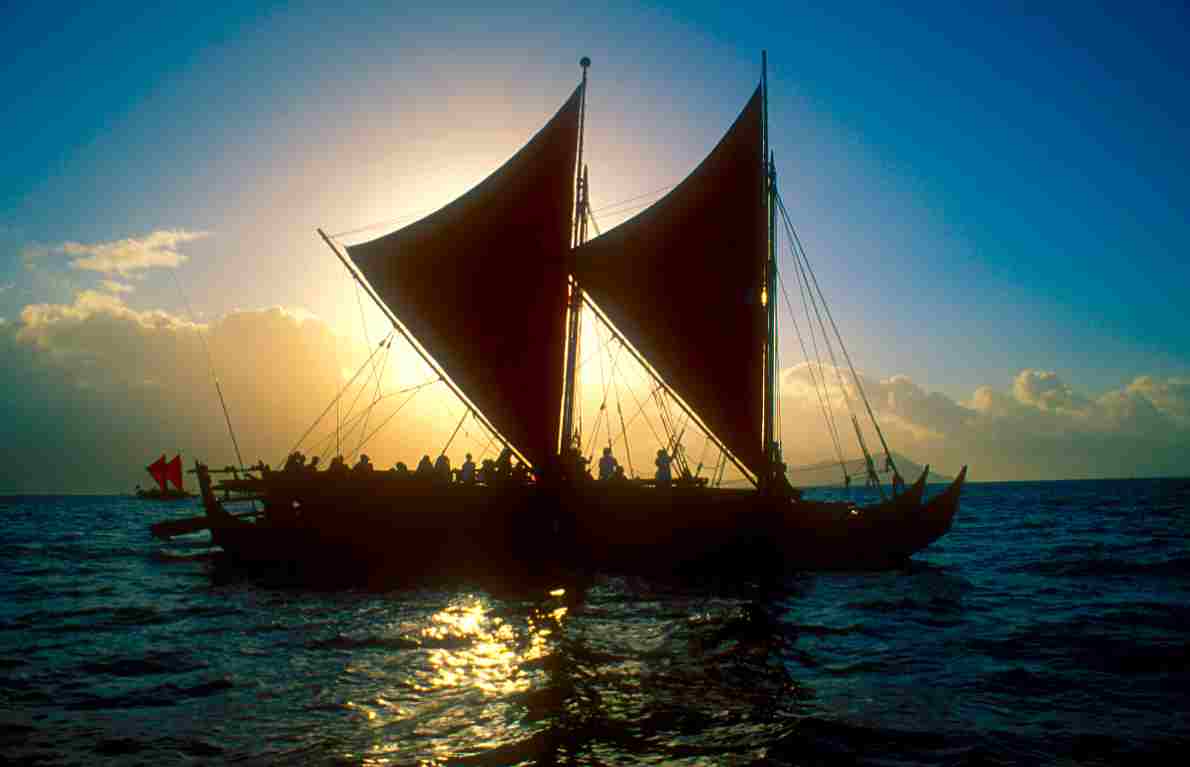|
'The
Spaceship of our Ancestors'-HOKULE'A
By
Sam Low
Wooden Boat Magazine
On the horizon's razor edge
at dawn, where a platinum ocean meets a brightening sky, I first saw the
sails-dark swaths filled by the northeast trade winds. Then four canoes
took shape, three big ocean voyaging ones-HOKULE'A (star of gladness),
MAKALI'I (eyes of the chief) and HAWAI'ILOA (named for a famous Hawaiian
chief)-and the small coastal canoe MO'OLELO, all reconstructions of boats
whose design dates back at least a millennium. It is March 12, 2000, and
I awaited their arrival at Kualoa on the island of Oahu, standing within
a charmed circle of men and women who had sailed these vessels, surrounded
by traditional priests in flowing robes garlanded with sweet smelling
maile leis.
Behind us stood dozens of hula troupes, singers and chanters, waiting
to perform traditional ceremonies of welcome that will continue into the
evening. Among those gathered in reverential silence are Polynesians from
Tonga, Samoa, the Cook Islands, Rapa Nui (Easter Island), Aotearoa (New
Zealand), the Marquesas, Tahiti-from all the corners of the great Polynesian
Triangle, ten million square miles of ocean sprinkled with islands like
tiny stars. All these people had come to celebrate the 25th anniversary
of the construction of one of these canoes, HOKULE'A, an event that has
inspired a far-reaching cultural revival.
In 1973, Hawaiian artist Herb Kane, anthropologist Ben Finney, and boatman
Tommy Holmes formed the Polynesian Voyaging Society (PS) to experiment
with the theory, supported by extensive scientific research, that Polynesians
had peopled the vast Pacific by long voyages intended for colonization
and exploration. Their first project was to build HOKULE'A-a reconstruction
of an ancient voyaging canoe-and sail it on a 5,000-mile round-trip between
Hawaii and Tahiti. Ancient canoes were fashioned from hollowed-out logs
caulked with breadfruit sap and fastened with coconut-fiber lashings,
but the knowledge of building such vessels-and the materials to build
them-had long since been lost in Hawaii. So they built a "performance
replica," accurate in outward appearance and function, but fabricated
from modern materials, in this case plywood sheathed in fiberglass.

Herb Kane - painting of Hokule'a
When HOKULE'A was launched at Kualoa on March 8, 1975, Nainoa Thompson-then
a 21-year-old Hawaiian crew member-attended the ceremonies. "It was the
first time," he remembers, "that I had heard an ancient chant in my own
language or seen a classic-style hula. My grandmother grew up in a time
when Hawaiians were beaten in school if they spoke Hawaiian and they were
ashamed to be dark-skinned. Ever since the arrival of Capt. Cook [in 1778],
we have been increasingly disconnected from who we are. But when I watched
HOKULE'A slip into the sea, it kindled in me something that I only partially
understood but felt instinctively-pride in my heritage."
The canoe rapidly proved her mettle in sea trials, but one key element
for the voyage to Tahiti was still missing-a navigator to guide her without
instruments or charts. Such knowledge existed only among a handful of
men called palu who still sailed outrigger canoes among the islands of
Micronesia, finding their way by natural clues to direction-the arc of
stars, the flight of birds, and the curl of ocean swells. So from the
tiny island of Satawal (a sister island to Puluwat) came Mau Piailug.
He would navigate HOKULE'A on her first voyage. Nainoa flew to Tahiti
to sail on the return trip, and he remembers HOKULE'A's arrival vividly.
"Seventeen thousand people came down, over half the population of the
island. It was a spontaneous reaction by a people who had maintained their
language and their genealogy, who understood who their great navigators
were. They knew about the great canoes, but they didn't have such a canoe.
So when HOKULE'A entered the bay, she was a powerful symbol that reminded
them of the greatness of their culture and their heritage-and therefore
themselves."

Nainoa Thompson
After returning to Hawaii aboard HOKULE'A, Nainoa found it difficult to
return to normal life. "The whole sailing experience was so powerful that
getting off the canoe left a huge void," he remembers, "I had to continue."
Working with his father, Myron "Pinkie" Thompson, who had been named president
of PVS, Nainoa planned another trip to Tahiti. In 1978, Mau Piailug returned
to Hawaii to teach him the secrets of navigation. "Mau trained us like
his grandfather had trained him," Nainoa says, "he took us on the sea
like children, becoming our father and mother on the ocean. We had very
few formal lessons: the learning really came by being close to him-looking
at the things he looks at, feeling the things he feels." After two years
of rigorous training, Mau proclaimed his young Hawaiian student ready
to navigate by himself.
In 1980, Nainoa became the first Hawaiian to navigate the ancient sea
route to Tahiti in perhaps a thousand years. This success added fuel to
a growing Hawaiian cultural revival that by then included dance, chant,
medical practices, architecture, and religion. "HOKULE'A was the spaceship
of our ancestors," as one Hawaiian put it, "she was the highest achievement
of our technology. She kindled our pride. And she taught us that as a
people we could do anything we set our minds to."
What Nainoa and others set their minds to in the following 20 years of
voyaging was nothing less than stitching together all the islands of Polynesia.
In 1985, HOKULE'A sailed to the Society Islands, the Cooks, New Zealand,
Tonga, Samoa, and back to Hawaii via Aitutaki, Tahiti, and Rangiroa in
the Tuamotu Archipelago. In 1992, she voyaged to the Pacific Arts Festival
in Rarotonga. And in 1995, she returned to Tahiti to join a fleet of Polynesian
sail for an epic voyage to Hawaii via the Marquesas called Na 'Ohana Holo
Moana-the Voyaging Family of the Vast Ocean. The family now included six
seagoing canoes in addition to HOKULE'A-from Tahiti came TAHITINUI, from
the Cook Islands came TAKITUMU and TE AU TONGA, from New Zealand came
TE AURERE, and from Hawaii two new canoes-MAKALI'I and HAWAI'ILOA.
"We call HOKULE'A the 'mother canoe,' " says TE AURERE's Maori captain,
Hector Busby, who had come to Kualoa to attend the canoe's 25th anniversary.
"She inspired us all to achieve something no one considered possible-building
a canoe of our own to rediscover our ancestral heritage as a seafaring
people, and through that the rediscovery of ourselves."
By 1995, HOKULE'A had sailed more than 75,000 nautical miles and had visited
all the frontiers of the Polynesian triangle except one-the easternmost-which
is occupied by a single island, Rapa Nui. In HOKULE'A's 1999 voyage to
"close the triangle," I served among Nainoa's crew.
As I stood in the throng awaiting the canoes' arrival at Kualoa almost
a year after that voyage concluded, my mind flashed back to days of cold,
stinging winds, and nights of crystalline beauty filled with planets as
bright as tiny moons and the swirling Magellenic Clouds. A burst of sound
from a dozen conch shells broke my reverie. HOKULE'A had touched ashore
at Kualoa. The welcoming ceremonies had begun. "Famous are the voyages
of HOKULE'A in the long seas, in the short seas, in the choppy seas of
Kanaloa, O Kanaloa, e Kanaloa of the long seas," proclaimed one of the
chanters in impeccable Hawaiian, reverently intoning the blessing of Kanaloa,
the Hawaiian god of the sea. Hula troupes garlanded with leis performed
dances that had not been seen for many generations. In song, oratory,
chant, and dance, Polynesians from the far frontier of the triangle demonstrated
what HOKULE'A had accomplished in her 25 years of voyaging-the full expression
of a renewed culture.
|



